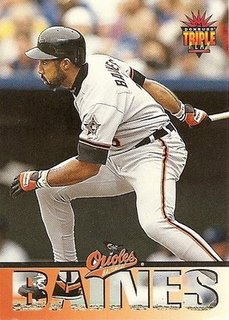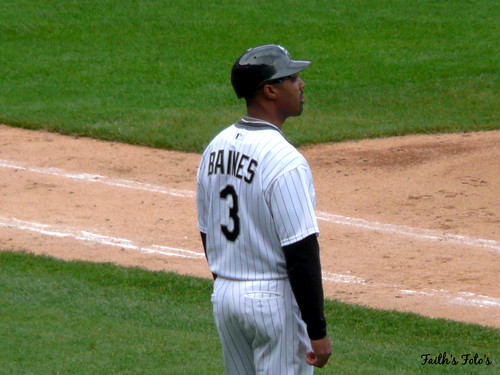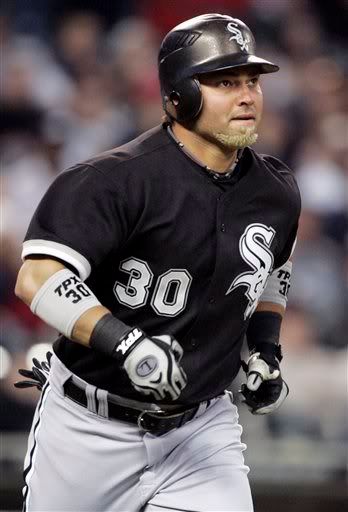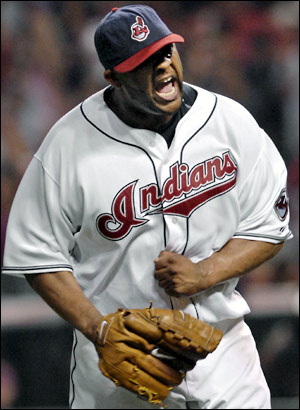Last week, Shyster Ball started a trend and a bunch of other bloggers has followed suit, so I figured I wouldn't be the worst copycat if I did my own 25 Random Baseball Things. Generally, when I get tagged in a note on FaceBook, I just ignore it because really, who cares? You may feel that way, too, and if so, well, you're entitled. You may stop reading whenever you like.
1. My mom is the reason I'm a baseball fan. My father left before I was three years old and wasn't much for sports anyway, as I understand it, unless they involved horses. Baseball being woefully equine devoid, I don't think he would have instilled the same love of the game, or at least of the Yankees, in me that my mom did.
2. She's no athlete, but my mom did her best to help me become one, or at least to prove that I was not, though that was never her design. When there were no kids around with whom to play catch, she would stand on the porch and toss baseballs to me, and would even throw a pop-up when I asked. Once I let a high pop get past my mitt and it hit me in the throat, giving me some trouble breathing for a few minutes. I kept better track of the ball after that.
3. I did not get to play in Little League. My family was pretty poor when I was a kid, my mom raising three kids by herself, on welfare for several years before my kid brother was in school full time and she could get a job. Sponsors may buy you uniforms, but cleats and gloves are (I think) your own dime, and we didn't have many of those to spare. I wasn't Omar Vizquel, using a milk carton to snatch grounders off a rocky field, but I did try using a welder's glove to catch once. Not sure where I found a welder's glove.
4. I did play a form of baseball in the apartment complex where I grew up. I lived in these rickety, old garden apartments in Lodi, NJ, commonly referred to as "Wrights Village" or simply "The Village", which had courtyards, some of which were useful for playing wifleball, stickball, and etc. The sidewalks in the courtyards formed quasi-diamonds, though they were hardly square. According to Google maps, it was about 30 feet from home to first, but more than 50 feet from first to second. A lot of us got tagged out trying for second.
5. We rarely had enough people to play a real game, and rarely had a hardball with which to play, so usually it was three or four on one, as we took turns at bat, using tennis balls and a wifle bat with newspaper stuffed down the end to give it weight. There was no need for a left or center fielder, as the buildings were only 40 feet away over there, and anyway, if you hit a fly ball to left, you had a pretty good chance of breaking a window, so we tried to avoid that. Anything over the roof was a homer, just like in the big leagues.
6. One way we made up for the lack of players was to use shopping carts as catchers. There was a supermarket around the corner from my house, and a lot of poor people without cars in the neighborhood, so there were always shopping carts laying around. We'd prop one up about 5 feet behind the home plate corner. The cart itself and the crossbar underneath served as a strike zone.
The long, shallow carts were a pitcher's best friend: For an 8 or 10 year old batter, the strike zone was two and a half feet wide and might have gone from his waist to six inches above his head...but it was official. If you got the ball in that box, it was a strike. Period. If not, you had to go back to the parking lot and find it under a car or (God forbid) in the sewer drain, so there was a lot of incentive to throw strikes. Nobody ever walked.
7. There were not many boys my age in that neighborhood, so I usually played against my brother and his friends, three years my junior. One of them, a hefty little bugger named Chris, played Little League and was considered a pretty good hitter. Though I was nothing special as a pitcher, with three years on him and at 25 feet away, even my modest "stuff" was hard to hit. I was padding my ego as I zipped "fast"balls by him into the cart one day, but he was clearly getting mad as he kept missing, so I took a little off the next one...and he hit it into the street, 200 feet away. Twenty years later, that still pisses me off.
8. I was interviewed once for a local TV station's 6 o'clock news, where they were filming "man on the street" types of clips for the sports portion, getting people's thoughts on the Yankees, who were constantly revamping their roster. For whatever reason, they thought that a 10-year old boy in front of the K-Mart in Lodi would make for a good clip, so they filmed me talking about how the Yankees seemed to be getting rid of all their good players for a bunch of "has-beens and never-will-be's", which I thought was clever. We watched that obscure cable TV station's news broadcast for days trying to see if I would be on TV, but to no avail. I don't think they ever used the clip.
9. I remember very little from my first big league game. I went with a group from the Lodi Boys and Girls Club to a Yankee game against the Blue Jays, probably around July of 1985 or 1986, and the Yankees lost. We sat in the bleachers and I got sunburned.
When I got home, I told my mom how I'd gotten to shake Ron Guidry's hand, since the bleachers are above the bullpen. I had an inexplicable propensity for making stuff up at the time, and this lie was one of the biggest. I guess I liked the attention. My mom believed me, too, I think. (By contrast, when I told my 3rd grade class that I had shot a bear at the age of 3, while living in Kentucky - a story lifted directly from the Davy Crockett legend - nobody bought it.)
10. I met Lou Pienella in the Nordstrom in the Garden State Plaza in Paramus, NJ when I was in high school. My mom recognized him and sent me over to get his autograph, and he was cool about it and shook my hand, too. (My mom was there to witness it, this time.) I told him that she and I were big Yankees fans. At the time, he was managing the Reds.
11. In high school, we played softball in gym class sometimes. I was skinny (6'5", 165 lbs in 11th and 12th grades) and so I didn't have much to offer offensively, but I knew my limits, and tried to slap hits over the second baseman's head to get on base. It rarely worked. Apparently you need some muscle for that, too.
Defensively, they put me in left field, where non-athletes always go, but here, my smarts paid dividends where my feeble frame could not. There was a guy named Pete in our class, nearly as tall as me but with 50 additional pounds of muscle. (And, now that I think of it, a lot of acne...maybe Alex Rodriguez's cousin injected him too?) Anyway, whenever Pete came to the plate, the cosmic elements of the slow pitches, his huge frame, his righty swing and his big ego would inextricably converge and he would smash the ball in to deep, deep, left field.
And I would be waiting under it, and catch it, every time. He got mad, and even remarked to me how frustrated he was about that, but strangely he never tried a different approach.
12. There was an old guy who used to hang out near a corner store a few blocks form my high school. A friend and I walked past him all the time, and tried to avoid talking to him because he would often monopolize us for several minutes and delay our plans to go do nothing for the rest of the afternoon. Anyway, the guy professed to be a catcher who had once played against Babe Ruth. He'd say, in his New Jersey accent, "You see deez fingaz?" and he'd show us his gnarly hands and make us guess which position he played, which was much easier after we got it right he first time.
As a cynical high school student, I didn't believe him of course, but knowing what I now know about barnstorming, I realize that this man was probably suffering from a gnome, or small dwarf living in his stomach. And that he was probably telling the truth, after a fashion.
13. I didn't get to another major league game until the summer of 1994. In July, a college mentor of mine took me to a Yankees-Mariners game. We got to sit right behind home plate, one section up, and Jimmy Key and his 12-1 record were starting for the best team in the AL against Dave Fleming and a 34-44 Seattle team, so I figured we had this one in the bag.
As it happened, Key gave up six runs in four innings and we lost, 12-6, though Bernie Williams hit a homer. The blow out wound up being a good thing, sort of, as a lot of people left and we got to sit right up against the backstop for the last few innings. Though I didn't realize it at the time, Goose Gossage pitched the last inning of that game for Seattle, one of the last of his now Hall of Fame career. Ken Griffey got five hits that day. I hated Ken Griffey.
14. I didn't get to another game for just over a year, as The Strike hit about a month later. July 12th, 1995, the day after the All-Star Game, saw the Yankees playing a bizarre one-game "series" against the Royals, presumably an artifact of the oddly truncated Strike Season.
The struggling Yankees started a rookie named Andy Pettitte against Chris Haney. This was a Wednesday night, back when 1/2 price Student Nights could get you half price to any seat in the house, not just the nose-bleeds, and we took full advantage. Two friends and I spent $12.50 apiece for Main Box seats behind first base, where Don Mattingly, my childhood hero and still my favorite player, was bound to be. It was Sock Night, both for us and the Yankees. We got free pairs of socks with the Yankees logo, and the Yankees socked nine runs on 11 hits and seven walks.
The first Yankee win I'd ever seen in person was the last game of the year for Chris Haney, who was terrible (and presumably injured) and did not pitch again that year. His relief, (oddly enough, Dave Fleming again) did no better in one of the last games of his career. Pettitte pitched the best game of his young career, allowing one run in 8.1 innings, and instantly became my favorite pitcher. Mop-up man Scott Bankhead got the last two outs uneventfully, pitched three more games in his career and then was gone from MLB.
15. The next game I attended was August 13th 1995, the day Mickey Mantle died, though I didn't know it until we got to the ballpark. Three friends and I drove in and listened to a music tape instead of the radio, so we didn't hear the news, but when we got there, the park was eerily quiet, despite the fact that it was packed. About 20,000 extra fans showed up that day, almost 46,000 total, compared to a normal Sunday home attendance of about 27,000.
There was no music on the loudspeaker, but the JumboTron said "#7...With Us Forever" and it was obvious. They had a video tribute to him and a moment of silence at the beginning of the game, and then the Yankees paid Mickey the greatest tribute of all: They went out and beat the best team in the AL.
Those Indians had Kenny Lofton, Carlos Baerga, Albert Belle, and Eddie Murray. Jim Thome hit 6th and and Manny Ramirez hit 7th, they were so good. David Cone, who had been with the team for just two weeks, knew the gravity of the situation, and he shut them down. Cone threw 129 pitches, earned a complete game, and surrendered only one run on a solo homer to Belle in the 6th. (Sadly, he was terrible for about three weeks after that, but winning a big game like that buys you a lot of slack.)
16. The next summer, I actually went to a baseball game about 7,000 miles from my home before I went to one 10 miles away in New York. A friend from college allowed me to join him for a week and a half in Japan with his parents, who were living there at the time, and they were gracious enough to get tickets to a baseball game. I didn't care who was playing, just that I got to see a game in Japan. We saw the Nippon Ham Fighters play the Chiba Lotte Marines at the Tokyo Dome, aka, the Big Egg, where the Yankees and Tampa would someday play the first official Major League game outside North America.
Both the game and the park were pretty nondescript, but it was fun watching the two teams' fans take turns rooting for them, whenever they were batting. (In Japan, opponents' fans are generally quiet while the other team is batting.) I don't remember who won, only that an American ex-Met named Eric Hillman started the game, and that my friend's mom "caught" a foul ball when it wedged between her back and her seat. Oddly, a stadium attendant collected the ball and gave her a voucher in return, which was good for a Nippon Ham Fighters' mascot key chain. She was nice enough to give me the key chain as a souvenir, which I gave to my mom. Not sure if she ever used it, and I can't say as I blame her, given how strange the mascot for that team is:
17. I didn't own a decent baseball glove until college. I had one as a kid, but it got lost, and I didn't have one I could wear as an adult until I bought a cheap, "pleather" glove in the summer of 1995. I was working as a security guard in a discount department store in South Hackensack, NJ, the kind of place where any self-respecting shoplifter wouldn't be caught dead, and one of the department managers got a sample glove from a vendor, which he sold to me for $5 or $10, I think.
It was so cheap that later that year, playing catch with my roommate in the quad at college, the baseball literally ripped right through the web of the glove. I can barely throw 65 mph. I asked for a real glove for Christmas and my grandparents sprung for a nice first baseman's mitt, which I still use.
18. The first baseman's mitt, along with several other gloves, a dozen baseballs and softballs, two bats, a catcher's mitt and mask, and size 15 cleats are in a bag in the trunk of my car, just in case a baseball game breaks out somewhere. I need to be prepared.
19. One of the gloves in that bag was acquired at my bachelor party. My best man arranged a softball game, and after the game, there was an extra mitt in my bag. There were about 20 of us playing that day, but nobody ever claimed it. Most of the baseballs are official Patriot League balls, which I get during the winters at the ballfield on Lehigh's campus. They have practices in the late winter/early spring, but sometimes it snows and they can't always find all the batting practice balls in the snowdrifts. But my dog can.
20. The best game I ever attended was a Yankees-Red Sox game in September of 1996. The Yankees trailed 6-1, 8-4 and 11-7 at different points in the game and left 20 men on base before finally winning 12-11 on a bases-loaded, 2-out, bottom of the 10th single by His Clutchness, which literally sent the Stadium rocking. My friends and I were in Row Y of the Tier Reserved section. There is no Row Z. We could actually feel the Tier bouncing as they played Gary Glitter and everyone jumped up and down to it. In 2007, I took my mom to a divisional playoff game, and they won, but even that was not as exciting a game.
21. The only time I've been to a Yankee game in my life without a glove was 11 September 1999. Nomar Garciaparra hit two home runs, and the second of them came right to me. I sprained a finger trying to catch it, to no avail. The Yankees lunch cooler freebies they gave out might have served as a makeshift glove if I could have thought that fast, but alas, 'twas not to be. When I got home, I taped SportsCenter so I could see myself on TV. That, too, was disappointing. But I always bring my glove, now.
22. I got to see the walk-off grand slam by Alex Rodriguez against the Orioles in April a couple of years ago. The rest of the game, in truth, was kind of a drag. My wife actually fell asleep for a couple innings, but woke up in time to enjoy the drama. You can read about that experience here.23. I got to see a walk-off homer by Barry Bonds at AT&T park in 2004, one of three places I've seen him (Citizens Bank Park and Dodger Stadium are the other two). You can read more about that here.
24. I have a collection of MLB team ceramic coffee mugs, which must be purchased in the city where the team plays. I still need the two Florida teams, San Diego, Oakland and Baltimore. I had Oakland and Baltimore mugs at one point, but the glued-on, die-cast metal logos tend to come off in the dishwasher.
I also have mugs from minor/independent league teams in Trenton, Newark, Camden, Rochester, and Huntsville, all places where I've gotten to see a game. I saw a game in Boise a few years ago, but they had no mugs, so I got a shotglass. The minor league mugs have to be from teams I've visited and watched in person, while the MLB mugs can come from a friend passing through the airport (as my Cardinals mug did, for example).
25. I have seen a minor league game in seven different cities, but an MLB game in only nine ballparks: Yankee Stadium, Shea, Camden Yards, Veterans Stadium, Citizens Bank Park, PNC, AT&T, Dodger Stadium, Jacobs Field, and Chase Field. I'm a little embarrassed to admit that I've been to three of the five NL West parks, and to professional games in Idaho, Alabama, Japan and South Korea, but never to Fenway.


























